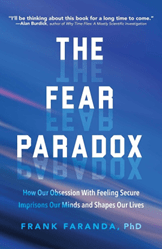
In the last article, we considered the “Taleb Surgeon Paradox” and how it related to how we are likely to make tough choices in our lives/careers about who we trust, who we choose as our mentors or who we “let cut us” like a surgeon. In summary, this paradox states that, “If you’re faced with a choice between two equally qualified surgeons, go with the one who doesn’t appear to be the part. They had to overcome more obstacles to reach their current level of success.” Further, Nassim Nicholas Taleb, the author of Skin in the Game, asserts that going solely off “the looks” can be a big mistake, especially when one’s decision is about something important. In fact, he suggests, “If forced to choose, choose the one that doesn’t look the part.”
For this article, we are going to look at The Fear Paradox. There are many ways to go on this one too. Post-Covid pandemic, the natural way to go is towards Frank Faranda’s book, The Fear Paradox. At Amazon, the book’s summary reads in part: “For years, Dr. Frank Faranda studied a state of fearfulness in his patients―an evolutionary state that relentlessly drove them toward avoidance, alienation, hypercriticism, hyper-control, and eventually, depression and anxiety. He began to wonder what they were afraid of, and how embedded these fears might be in contemporary society. This book aims to break us free from what he found…Faranda’s Fear Paradox is simple―even though fear has a prime directive to keep us safe and comfortable, it has grown into the single greatest threat to humanity and collective survival. As a consequence, fear is embedded in our culture, creating new dangers and inciting isolation. With rising anxiety levels, now is the time to shine a light on our deepest fears and examine the society that fear is creating.”
Looking at that list in the summary, one can feel somewhat overwhelmed and that is certainly something that fear brings. Some would say that fear is something we should not have, should avoid or should minimize. I would, for the sake of this article, prefer not to make such an assumption. Instead, I would like to look at ways that fear can be useful, motivational and even beneficial in our personal and professional lives as PGA professionals. At the same time, fear can be debilitating, limiting and burdensome in ways that affect our work and personal lives.
What can we do with our fear with intentionality? If we want to go forward, change our trajectory, make a difference, we all know this hard truth: “Change is necessary.” Legendary leadership speaker, Dr. John Maxwell says it best in this “Four Reasons People Change” video. Fear plays a role in the first reason of the four listed below.
- They hurt enough, they have to (change)
- They see enough, they’re inspired to (change)
- They learn enough, that they want to (change)
- They receive enough, that they’re able to (change)
It’s hard to say how much “hurt is enough” to cause change in a given situation, for a given person, but one can see how fear can play a role in it. Fear of “not having enough qualifications” if one sees where one’s skills are lacking, the fear of being “passed over” may cause them to take action to get more education or get more skilled. So, maybe fear shows up in at least two of these reasons listed by Maxwell.
With this in mind, let’s assert that Fear is fuel to motivate, to push and to propel us when we need it…just think a bit about how you’ve been driven to finish portions of the PGM Associate program (or the Apprentice Program if you’re my age.) Fear of being suspended, of losing playing privileges in one of the PGM Levels, has driven many to “get after it” and finish the Level, get that Class A, etc.

Thomas Waschenfelder’s post on “X/Twitter” in 2021 alludes to this. He wrote, “The opposite of fear is not courage. It’s action. Go make something.” I like this quote because it infers how fear, as something like an ignitor, causes action and in that action, there is a positive change. Maybe not a big change or a big difference, but something better than the status quo.
In reading Waschenfelder’s writing on this subject, I appreciate several of his observations that are applicable to our roles as “golf community professionals” including the following:
Getting Past Our Fears with Other People Is a Game Changer for Golf Professionals. We are in the people business, creating customer-centric hospitality experiences through the connections we often create or design in a structured event or “on the fly.” That can, at times, be scary. Knowing when to be the “entertainer who brings people together” or the “pro in the background who orchestrates an amazing circus” is sometimes a challenge, but the best in our industry know how to do it and when to do it. Waschenfelder quoted Nassim Nicholas Taleb (author of Skin in the Game) who wrote: “You have a calibrated life when most of what you fear has the titillating prospect of adventure.” For us, I believe this refers to the challenging joys of being that golf professional who knows what levers to pull in a given situation and isn’t afraid to pull them either.
Waschenfelder also wrote three phrases that I’d like to highlight including:
- Do More Stuff That Scares You. He said, “The more scary stuff you do, the less fear you’ll carry around and the further you’ll be able to push into the unknown…Because the opposite of fear is not courage. It’s action. The more scary stuff you do, the less fear you feel…If you’re scared of something, go try it. See what it feels like. More likely than not, it’s not as bad as you think.”
- Sahill Bloom wrote some similar things when he said, “The thing you fear the most is often the thing you most need to do.” Instead of allowing a fear to be the obstacle, consider the fear as “the way” to the next level of success or similar. Bloom also states that, “The most successful people in the world have all made a habit of running towards the thing the scares the hell out of them.” I’m picturing Walter Payton, famed running back of the Chicago Bears or someone like him. Need some inspiration, check out this video: Walter Payton Career Highlight Feature | NFL. Ray Lewis, hall of fame linebacker, said of Payton (nicknamed “Sweetness”), “Once you put wisdom, with will on top of talent, you get what you call sweetness.” What obstacle clothed in fear do you need to run at and run over in the next 120 days?
- Another good one is, “Make a habit of getting closer to your fears—treat them as magnets for your energy and you’ll find growth on the other side.” Again, this view treats the fear(s) as a light on the path to growth, improvement or whatever you are seeking. The easy path is comfortable, the path for growth is “lit up” with fears, challenges, obstacles and similar. Choose the growth path.
- You Fear a Downside That Doesn’t Exist. From what he wrote, I believe he meant this generally in a professional sense or an entrepreneurial sense. He stated that, “What you’ll quickly learn is that the downside you were anxious about is not nearly as disastrous as it looked from afar…When you really look at it, your worst-case scenario isn’t actually that bad.”
- I refer to these worst-case scenarios (in a career) as “bad beats.” Sure, they suck at the time, and they hurt too…but they generally cause introspection and self-reflection to occur (or at least they should) so growth, learning and correction can occur. In my case, some of the most significant “bad beats” of my career (e.g. not getting what I thought was my dream job, or having my current job diminish so much that I had to look elsewhere) turned out to be the best thing for my career as they caused me to change course and resulted in greater success, more meaning and growth.
- Most of What you Fear Will Never Happen. In this final one, Thomas Waschenfelder infers that while we are playing the “waiting in fear game,” paralyzed by what might happen, we are actually wasting time being stuck in fear of what might happen (but probably won’t.) He writes: “Once you take action, you also learn that the vast majority of what you fear most will never come to pass. Your worst nightmare rarely becomes a reality.”
- He added, “This doesn’t mean you ignore the possibility though. Do what you can to protect yourself from serious downside. As Taleb says in Antifragile, fear should transform into prudence, not ignorance: “The modern Stoic sage is someone who transforms fear into prudence, pain into information, mistakes into initiation, and desire into undertaking.” (Good stuff there.)
- I agree with Waschenfelder. His take in a simple way is: “Fear should never stop you from taking action.” I would add that fear shouldn’t stop you, if anything it should fuel you to take the necessary action(s) or make the right steps to move forward.
- With that said, maybe this fall and winter are the right time to: Start…start now.
As always, I hope you got some worthwhile things to consider from this paradox. Next time, we will consider The Looking Paradox (You may have to stop looking in order to find what you are looking for) in part XI of our Paradox Series. Thanks for taking the time to read this article. If you have a story to share, an issue you’re facing professionally or similar, please reach out to me when you can. If you are seeking any help with your career or similar, please click on the “Book an Appointment on Monte’s Calendar” link below.

Monte Koch, PGA Certified Professional, CIC
[email protected] | 206.335.5260
PGA of America | PGA Career Services | Career Coach & Consultant
Certified Interview Coach | Certified Predictive Index Practitioner
Based in South King County, WA